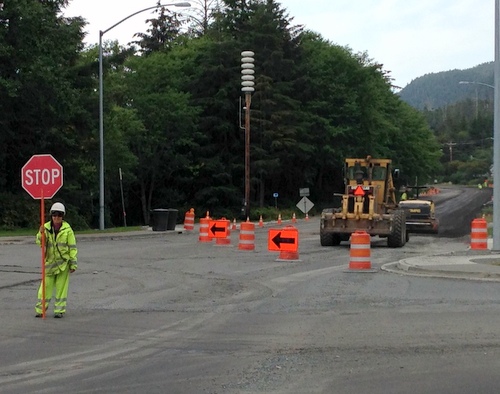
Contractors roll out the CABC, or “Crushed Asphalt Base Course,” in preparation for paving HPR outbound from SeaMart. The DOT says the road will be finished — or have a temporary surface — by the end of the paving season mid-September. (KCAW photo/Robert Woolsey)
Sitka drivers frustrated by poor road conditions on Halibut Point Road during this summer’s paving project can take heart: It’s going to get better.
Al Clough, the Southeast Regional director for the Department of Transportation says that while heavy rains have been a setback, the road will be done — or a driveable temporary surface in place — by the end of the paving season a month from now.
The current break in the weather might mean contractors can get another couple of miles of pavement down. That will be welcome relief from the bone-rattling ride that prevailed for the first three weeks of August, and was especially bad during the weekend’s heavy rainstorms.
Al Clough says the DOT heard from a lot of unhappy residents on HPR.
“It was just a disaster for a couple of days. You can go in there and add D-1 (gravel) and grade it flat. And two hours later it looks like the moon, there are so many potholes in it.”
The problem is that there is no roadbed once the pavement is removed. Paved roads are not built over sturdy gravel roads; rather, Clough says there’s a three-step process to make pavement: Step 1 is laying down a mixture of ground-up old pavement, cement, and asphalt oil. It’s called “Crushed Asphalt Base Course,” or CABC. This first step requires absolutely dry weather, which has been hard to come by this August.
Step 2 is laying down ATB, or “Asphalt Treated Base.” ATB is very tolerant of moisture. In fact, Clough says contractors can put down ATB in the rain.
So what looked like road paving last week in driving rains was that Asphalt Treated Base going down.
ATB is handy for another purpose: It makes a pretty good temporary driving surface, if continued heavy rains force the contractor to suspend operations for the winter.
Clough says this is the fallback position for every single paving project in Southeast.
“What we would do is install the ATB product over the roadway that’s torn up. That would be a sacrificial surface to give everybody a respectable driving surface through the winter months. Then come back in next year, grind part of that off, and finish the job.”
Finishing the job means putting down the actual hot-mix asphalt, which is somewhat tolerant of moisture. Hot-mix can go down in a drizzle, for example.
Clough thinks we’ll get to hot-mix in Sitka this year. Two miles of road from the roundabout to SeaMart are already done. The new bridges are in, and two more miles are ready for pavement if Mother Nature cooperates.
“We are optimistic, especially with this stretch of weather that we’re in right now, that we will get this project completed and paved out this season. There may be some of this subsidiary work that may go into next season. But right now if we get an even break with the weather at all, we’re looking good to finish it out.”
Some of the subsidiary work would be paving driveways that connect to the road, guardrails, and striping.
Clough says contractors are trying to put the project into high gear, after a setback earlier in the summer, when grinding equipment encountered some previously unknown utility patches across the roadbed. The patches — made of concrete — may have been installed decades ago. A contractor from Portland used ground-penetrating radar to find the remaining patches, which caused delays in the project until about August 1.
Clough says an additional grinding machine has been brought in from Prince of Wales Island to speed things up, and “paving weather,” as Clough calls it, should last a few more days.






























